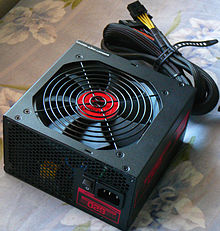- Corsair Memory
-
Corsair Memory 
Type Private Industry Computer peripherals
Computer hardwareFounded 1994 Headquarters 46221 Landing Parkway
Fremont, California, U.S.Key people Andy Paul (President & CEO)
Nick Hawkins (CFO)
Jose Flahaux (Sr. VP of Operations)Products DRAM Modules
USB Flash Drives
ATX Power Supplies
Computer Cases
CPU and Memory Cooling
Solid-state drives
Gaming AudioRevenue US$325.63 million [1] Employees 383 [2] Website www.corsair.com Corsair Memory is a computer peripherals and hardware company headquartered in Fremont, California. Corsair designs and sells a range of products for computers, including high-speed DRAM modules, ATX power supplies (PSUs), USB flash drives (UFDs), CPU and memory cooling solutions, computer cases, solid-state drives (SSDs), and speakers.
In addition to its worldwide headquarters in Fremont, CA, Corsair maintains a production facility in Taiwan for assembly, test, and packaging of select products, distribution centers in Asia, the United States, and Europe, and has sales and marketing offices throughout the United States, Europe, and Asia.
Contents
History
The company was founded as Corsair Microsystems in 1994 by Andy Paul, Don Lieberman, and John Beekley, Corsair originally developed Level 2 cache modules, called Cache-On-A-Stick or COAST modules, for OEMs. After Intel incorporated the L2 cache in the processor with the release of its Pentium Pro processor family, Corsair changed its focus to DRAM modules, primarily in the server market. In 2002, Corsair began shipping DRAM modules that were designed to appeal to computer enthusiasts, who were using them for overclocking. Since then, Corsair has continued to produce memory modules for PCs, and has added products in other PC components as well.
Products
DRAM Modules
Corsair produces a full range of DRAM memory modules, spanning DDR1, DDR2 and DDR3 memory types, with both dual-inline memory modules (DIMMs) for desktop PCs and small outline dual in-line memory modules (SODIMMs) for notebook and netbook PCs.
USB Flash Drives (UFDs)
Corsair products a number of different USB flash drives, ranging in capacity from 4GB to 128GB.
Power Supply Units (PSUs)
Corsair designs and sells ATX-compatible PSUs, in both modular and non-modular formats, ranging in output from 400 watts to 1200 watts. Most Corsair PSUs are 80Plus certified as energy efficient.
Computer Cases
Corsair designs and sells cases for PCs, in both mid-tower and full tower sizes. Their cases are designed to accommodate motherboards in the standard ATX, micro-ATX and mini-ITX form factors.
CPU and Memory Cooling
Corsair offers fan-based air and closed-loop water cooling products for Intel and AMD CPUs, as well as fan-based air coolers for memory.
Solid-state Drives (SSDs)
Corsair has a range of solid-state drives, based on SSD controllers from multiple suppliers, including Samsung, SandForce, Indilinx, and JMicron.
Gaming Audio
In September, 2010, Corsair announced and began shipping the Gaming Audio Series HS1 USB Headset, marking its entry into the gaming audio market. The HS1 includes Dolby Headphone technology, allowing 5.1 and 7.1 surround sound content to be played back through stereo headphones. Corsair released its SP2500 2.1 high-power speakers in early 2011 along with a lower end system, the SP2200.
Innovations
Enhanced Performance Profile (EPP)
An extension to the JEDEC standard Serial Presence Detect (SPD), EPP was jointly developed for DDR2 by Nvidia and Corsair in 2006 to make the process of overclocking memory easier. EPP was later extended by NVidia to EPP2 for DDR3 and further modified by Intel for their eXtreme Memory Profile (XMP) system.
Xpert Memory Modules
In 2009, Corsair was awarded U.S. Patent 7,584,006 for technology first used on its Xpert range of DRAM modules, which included a microprocessor-based system for controlling, measuring, and reporting multiple operational parameters, including frequency and activity.
Dual-path Heat eXchange (DHX)
In 2009, Corsair was awarded U.S. Patent 7,606,034 for its DHX technology, which uses a specially-designed PCB and heat spreader to remove excess heat from both the front and rear of the memory IC, as well as from the printed circuit board (PCB). High temperatures can cause memory failures, system lockups, and other problems, and overclocking causes the DRAM ICs to generate even more excess heat. DHX provides an efficient way to improve heat dissipation, increasing system performance and stability.
In 2009, Corsair also introduced DHX+, an update to the original DHX heatspreader design that allowed for additional memory module cooling options to be used. One example is the Corsair Ice Series T30, a thermo-electric cooler that can cool DHX+ equipped memory modules below the ambient temperature.
In 2010, Corsair updated DHX again, introducing DHX Pro, which extended DHX+ by adding circuitry to the custom PCB allowing measurement of both activity and temperature on the module, as well as a connector to allow this data to be read by external devices. The first device announced, the Corsair Airflow Pro, which mounts to the Corsair Airflow memory cooler, reads the parametric data from Dominator modules with DHX Pro and displays temperature and activity through a series of colored LEDs.
Corsair Link (Parametric Measurement and Control)
At the 2011 Consumer Electronics Show in Las Vegas, NV, Corsair announced a new technology, called Corsair Link, that it is developing to allow parametric measurement and control of specific Corsair products that include Corsair Link connectors. The technology creates an "intelligent" system through software-connected hardware devices. Corsair showed a Corsair Link system including Dominator GT modules with Airflow Pro, a Hydro Series H60 CPU cooler, along with fan and lighting controllers, all connected via a Windows-based application.
See also
- Flash memory
- DIMM
- Power supply unit (computer)
- List of PC hardware manufacturers
References
External links
Categories:- Companies established in 1994
- Computer memory companies
- Computer power supply unit manufacturers
- Companies based in Fremont, California
- Privately held companies based in California
Wikimedia Foundation. 2010.

